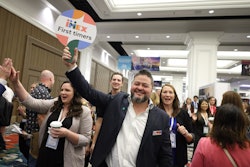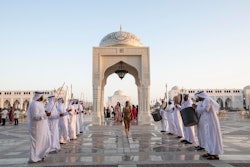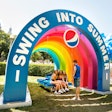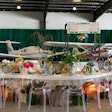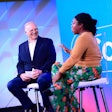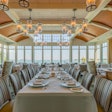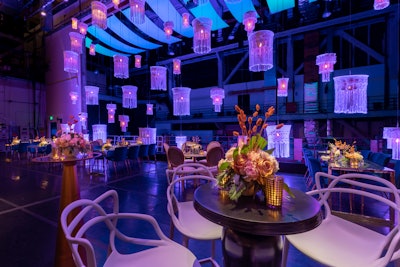
Like many nonprofit events, the San Francisco Symphony’s annual Opening Night Gala offers a variety of ticket tiers and event options that appeal to donors of varying income levels. The natural result? Four separate dinners that each tend to draw different generations of attendees—and the design team at Blueprint Studios keeps those demographics in mind while creating each space.
One intimate area hosts a dinner earlier in the evening, for example, and adopts a classic color palette that might appeal to older attendees. The lower-priced spaces, meanwhile, include a more casual hors d'oeuvre-focused reception with a slightly bohemian theme, while concert-only ticket holders go right to a festive alfresco after-party with food stations from local eateries. Although patrons can choose to purchase whatever ticket level they'd like, of course, the event is a great example of how to cater to various age groups at the same gathering—without sacrificing the experience for anyone.
The key is to not lean too heavily on generalizations, notes Austin-based entrepreneur and marketing specialist Chad Price.
“We often stereotype certain demographics and make assumptions about their needs, wants, and attributes," he explains. "Often, there are more similarities between different generations than we might realize, and finding common ground can help to forge connections between a diverse range of people and facilitate a successful event. Look for shared priorities, passions, and purposes in the people attending the event, and be sure to highlight these.”
Amanda Ma, CEO of Innovate Marketing Group in Los Angeles, also advises starting with the commonalities. Every generation, regardless of age, is drawn to experiential elements that create lasting memories, she says, along with networking opportunities (“though the preferred methods may differ,” Ma notes) and a great guest experience. Other commonalities? An interest in “diversity and inclusivity, ensuring a welcoming environment for all attendees, and purpose-driven events that resonate across generations."
So, how do you begin creating an experience that caters to diverse age groups—without relying on stereotypes? Ma suggests conducting audience research to understand demographics and preferences and offer flexible, personalizable programming to accommodate various interests. Similarly, “craft thoughtful communication that resonates with each generation, and focus on the attendee journey experience.”
To help establish some general rules of thumb, we caught up with Ma, Price, and other event experts to learn some quick tips for what they see working now with multigenerational events.
Programming:
According to Ma, Gen Z (born 1997-2010) tends to prioritize “immersive experiences, interactive technology, and sustainability initiatives.” This is the most diverse demographic in history, with almost 50% of young Americans identifying as BIPOC and almost 20% identifying as LGBT. This group, in particular, tends to look for a certain level of interaction and co-creation at their events and is most likely to be passionate and outspoken about their values and the brands and companies they align with.
Although they have a lot of overlap with the younger group, millennials (1981-1996) may be more focused on “personalization, meaningful connections, and self-expression opportunities,” Ma adds. Gen X (1965-1980), meanwhile, wants “convenience, quality, and networking opportunities,” and baby boomers (1946-1964) lean toward “traditional formats, face-to-face interactions, and well-planned agendas," she continues.
Programming-wise, offering a mix of session formats and topics, along with a diverse lineup of speakers, can create a well-rounded program that can appeal to all ages. Carissa Kruse, founder of Carissa Kruse Weddings in Denver, adds that “Gen Z and millennials often seek events that are more casual, with an emphasis on experiences and technology. On the other hand, Gen X and boomers tend to prefer a more traditional type of event, with a greater focus on socializing and entertainment. You see the point, however, when you look at the commonalities between generations—all four groups are looking for events that are meaningful and enjoyable.”
Venues:
In terms of event spaces, younger generations tend to “want boutique spaces that have been repurposed—old warehouses, silos, packing plants, etc.,” says Nikki Yep, Los Angeles-based senior event planner at Event Solutions. “The more unique the space, the better the story—the more attractive it is to them. The venue itself is part of the experience, whereas traditional generations like hotels and banquet spaces.”
Timing:
“Younger companies are opting to plan their events on a weekday versus a weekend,” adds Yep. “The most popular days have been Thursday and Friday.”
Technology:
“When it comes to technology, you should think about how to make it accessible and engaging for all generations,” says Kruse. Don't assume older generations want no technology whatsoever—just ensure it has clear instructions and a clear purpose. “For example, you might use tablets for guests to interact with each other or even play games. You can also have a tech-enabled photo booth with livestreaming capabilities to keep the younger generations engaged and entertained.”
Yep adds that younger generations tend to have certain expectations when it comes to technology integration. “Social hashtags printed on photo backdrops or on signage, social media handles, and even QR codes replacing handout pamphlets are all common in younger generations' events," she says, adding: “They have a higher standard for expectations of screen quality (think LED versus projectors) and innovative use within the event (think green screen photo booths)."
Communications:
Ensure that you customize your marketing and communication approaches to effectively engage your desired target audience. This can be achieved through leveraging social media platforms, employing email marketing, and implementing targeted advertising methods to connect with specific age groups or communities. Dedicate efforts to shaping messages that strike a chord with each demographic, emphasizing the distinctive elements of the event that will appeal to them.
“Of course, it’s important to accommodate everyone, if possible, but don’t focus too much on age. Trying too hard to adopt phrases, language, and buzzwords that are for younger or older people can be really cringeworthy and miss the mark,” advises Price. “Stay authentic and avoid assumptions."
Food and Beverage:
“Younger generations are all about experiences, adding new and innovative takes on everything—especially food,” says Yep. “Food science experiences are popular with them: Think customizable, made-to-order with an extra flair. Action stations are our go-to for younger generations, whereas for traditional generations we go for a set menu (buffet or plated). To accommodate both, we often include a mixture of action stations and a buffet.”
As for drinks, “Mixology and craft cocktails (or mocktails) are all the rage with the younger generations, whereas the older generations enjoy beer and wine,” Yep adds. “To accommodate both, we often include a couple of featured craft cocktails, local craft beers, and traditional beer and wine options.”
Entertainment and Activities:
Besides the obvious differences in musical tastes, Yep points out some additional differences she's noticed. Older generations may be drawn to entertainment like fortunetellers, caricature artists, traditional photo booths, and live music, “whereas younger generations like more activations and excursion-style entertainment,” she says, adding: “They prefer DJ and mixed music, green screen photo booths, and unique options that enhance and enrich their life experiences.”
A good way to accommodate multiple age groups? Offer a range of choices. “Recently, we did a company excursion that included golf for those who wished and off-roading in the desert for others,” Yep cites as an example.
Jaye Harrison, owner and founder of Parties Made Personal in Australia, also likes incorporating a mix of activities, interactive elements, and entertainment types. And sometimes, it can be fun to lean into generational differences! “I recall organizing a family reunion with ages ranging from 6 to 86. We used a 'through the decades' theme, and each generation was responsible for an activity tied to their decade," she remembers. "The result was a resounding success, with every age group interacting, learning, and having fun together."
Reflecting on this, Harrison adds, "I believe the future of event planning lies in embracing diversity and crafting experiences that connect everyone. But, above all, it's about creating a sense of belonging, making everyone feel like the event was tailored just for them."




